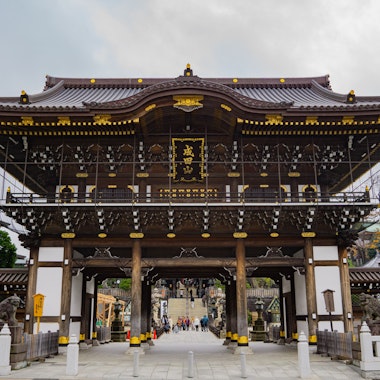


Naritasan Shinshoji Temple stands as one of Japan's most significant Buddhist sites, located in central Narita, Chiba Prefecture, just 8.5 kilometers from Narita International Airport. Founded in 940 AD by Kanchō Daisōjō, a disciple of Kōbō Daishi, the temple was established to commemorate the suppression of a rebellion led by the powerful samurai Taira no Masakado. The temple is dedicated to Ācala (Fudō Myōō), the "Unmovable Wisdom King," typically depicted holding a sword and rope surrounded by flames.
The temple is a lead temple in the Chisan branch of New Shingon Buddhism and includes a large complex of buildings and grounds. After remaining a humble provincial temple for over six centuries, Naritasan's prominence grew dramatically when Tokugawa Ieyasu moved his capital to Edo in 1603. The temple's fame expanded further through its connection to kabuki theater, particularly through the devotion of actor Ichikawa Danjūrō I, who credited Fudō Myōō for his son's safe birth and promoted pilgrimages to the temple among his audiences.
Visitors to Naritasan experience a blend of ancient and modern architecture. Several structures have been designated National Important Cultural Properties, including the Kōmyō-dō built in 1701, the three-storied pagoda constructed in 1712, the Niōmon main gate from 1830, the Shaka-dō dating to 1858, and the Gaku-dō completed in 1861. Modern additions include the Great Main Hall from 1968 and a 58-meter high Great Pagoda added in 1984. The sacred Goma fire rituals, performed several times daily, allow visitors to witness monks burning wooden tablets inscribed with wishes in a purification ceremony that has continued since the temple's founding.
The temple grounds span approximately 330,000 square meters, extending into the adjacent Naritasan Park, which covers 16.5 hectares and features walking paths, ponds, and seasonal beauty including plum blossoms in early spring and autumn foliage. The temple holds particular significance during annual celebrations, attracting over 3 million visitors during the New Year period alone, making it the second most-visited temple in Japan after Meiji Shrine. The Setsubun Festival in February features celebrities and sumo wrestlers participating in traditional bean-throwing ceremonies.
The temple is easily accessible from both Narita Airport and Tokyo. From the airport, it requires just a 10-minute train ride to Narita Station, followed by a 10-15 minute walk to the temple along the historic Omotesando shopping street, which features traditional shops and restaurants. Visitors can reach the temple from either JR East Narita Station or Keisei Narita Station. The main temple grounds are open daily with no admission fee, making it an accessible destination for both short-term airport layovers and dedicated cultural visits.